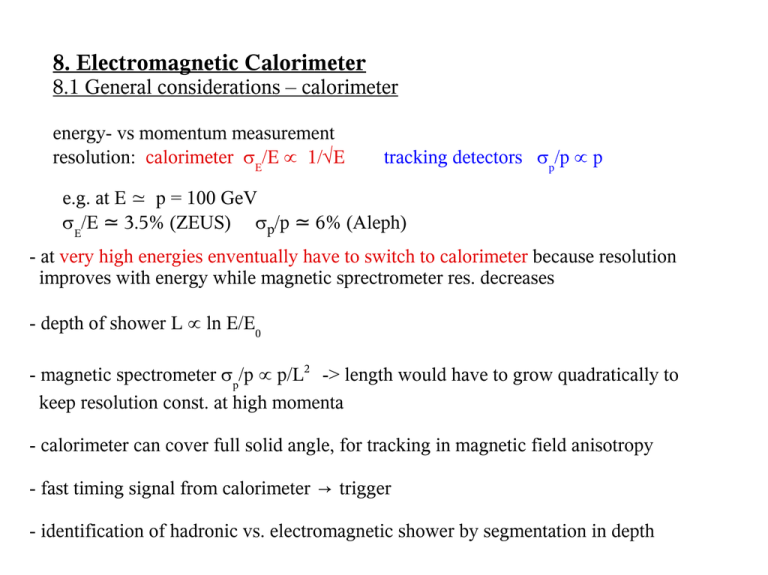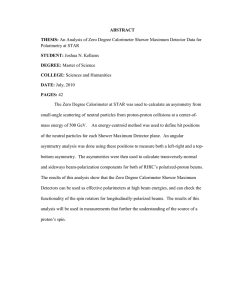8. Electromagnetic Calorimeter
advertisement

8. Electromagnetic Calorimeter 8.1 General considerations – calorimeter energy- vs momentum measurement resolution: calorimeter σE/E ∝ 1/E tracking detectors σp/p ∝ p e.g. at E ≃ p = 100 GeV σE/E ≃ 3.5% (ZEUS) σp/p ≃ 6% (Aleph) - at very high energies enventually have to switch to calorimeter because resolution improves with energy while magnetic sprectrometer res. decreases - depth of shower L ∝ ln E/E0 - magnetic spectrometer σp/p ∝ p/L2 -> length would have to grow quadratically to keep resolution const. at high momenta - calorimeter can cover full solid angle, for tracking in magnetic field anisotropy - fast timing signal from calorimeter → trigger - identification of hadronic vs. electromagnetic shower by segmentation in depth 8.2 Electromagnetic shower reminder: electrons loose enery by excitation/ionization of atoms and by bremsstrahlung dE E =¡ with X0 ≡ radiation length dx X0 E = E0 exp(¡x=X0 ) for sufficiently high energies: since (dE/dx) ion ∝ 1/2 ≃1 at high energies and logarithmic rise is weak for bremsstrahlung ( dE dE ZE )brems =( )ion ¼ dx dx 580M eV critical energy EC: ( dE dE (E = Ec ))ion = ( (E = Ec ))brems dx dx and for E > EC bremsstrahlung dominates : will see below that also transverse size is determined by radiation length via the Moliere radius 21M eV RM = X0 Ec examples: Pb plastic scint Fe Ar (liquid) BGO Pb glass (SF5) X0 (cm) Ec (MeV) 0.56 7.4 34.7 80 1.76 21 14 35 1.12 10.5 2.4 11.8 RM (cm) 1.6 9.1 1.8 9.5 2.3 4.3 Monte-Carlo simulation of an electromagnetic shower analytic shower model: high energy electron enters matter - electron looses energy by bremsstrahlung - photon is absorbed by pair production Monte-Carlo simulation of electromagnetic shower γ + nucleus → e+ + e- + nucleus e + nucleus → e + γ + nucleus approximate model for electromagnetic shower: - over distance X0 electron looses via bremsstrahlung half of its energy E1 = E0/2 - photon materializes as e+ e- after X0, energy of electron and positron E± ≃ E0/2 (precisely: p = 7/9X0 or pair creation probability in X0 -> P = 1-exp(-7/9) = 0.54 assume: - for E > EC no energy loss by ionization/excitation - for E < EC electrons loose energy only via ionization/excitation - important quantities to charakterize shower number of particles in shower location of shower maximum longitudiual shower distribution transverse shower distribution (width) shower model (continued): longitudiual variable t= x/X0 number of shower particles after traversing depth t: N (t) = 2t E0 ln(E0 =E) each charged particle has energy E= = E0 2¡t ! t = N (t) ln2 total number of charged particles with energy E1 N (E0 ; E1 ) = 2t1 = 2ln(E0 =E1 )=ln2 ¼ E0 =E1 number of particles at shower maximum shower maximum located at N (E0 ; Ec ) ¼ E0 =Ec / E0 tmax / ln(E0 =Ec ) numerical values: tmax ≃ 3.5 and Nmax≃ 45 for E0 = l GeV integrated track length of all charged particles in shower tX max T = X0 2¹ + t0 Nmax ¹=1 E0 = (4 + t0 ) X0 / E0 proportional to E0 ! Ec with t0 being the range of electron with energy Ec in units of X0 E0 for practical purposes: T = X0 F Ec (F < 1) Transverse shower develoment: - emission of bremsstrahlung under angle - multiple scattering of electron → multiple scattering dominates tranverse shower development described by Moliere radius useful relations: 95% of energy within 8.3 electromagnetic calorimeter (i) homogeneous shower detector (absorbing material ≡ detection materials) scintillating crystals (see chap.5) contributions to the energy resolution: - shower fluctuations Ε/Ε ∝ 1/E - photon/electron statistics in detector " - shower leakage Ε/Ε ≃ const. - electronic noise - calibration total Ε/Ε ∝ l/E Ε/Ε ≃ const. ← energy resolution of em. calorimeter example of modern crystal calorimeter: PHOton Spectrometer (PHOS) in ALICE: array of 22 x 22 x 180 mm3 PbWO4 crystals - in total about 18 000 (same type as CMS) dense, fast, relatively rad. hard, emission spectrum 420 – 550 nm read out with 5 x 5 mm2 avalanche photodiodes (see above, chapter scintillation detectors) Q = 85%, charge sensitive preamplifier directly mounted on APD depth 20 X0 light yield of PbWO4 relatively low and strongly temperature dependent -> operate detector at -25 deg C (triple light yield vs 20 deg C) but need to stabilize to 0.3 deg C (monitor with resistive temperature sensors) crystals cold, electronics warm (liquid coolant, hydrofluoroether) 12.5 t of crystals covering 8 m2 at 4 m from intersection point in front: charged particle veto (MWPC with cathode pad read-out) test beams of pions and electrons at CERN PS and SPS: 0.6 – 150 GeV 1/E term 1/√E term electronic noise: 1 ch = 400 e -> noise about 800 e why does resolution matter so much? peaks sit on combinatorial background, S/N strongly depends on resolution Alternative: instead of scintillating material use Cherenkov radiator electrons and positrons of electromagnetic shower emit Cherenkov ligth number of photons Nph proportional to total path length T of electrons and positrons (see chapter 2) Nph / T / E0 remember: energy loss by Cherenkov radiation very small -> resolution limited by photoelectron statistics typical:about 1000 photoelectrons per GeV shower energy mostly used: lead glass, e.g. SF5 n = 1.67 thr= 0.6 or Ethr= 0.62 MeV for electrons blocks of typical size 14 x 14 x 42 cm diamater 3.3 RM and depth 17.5 X0 read out with photomultipliers p typical performance: ¾E =E = 0:01 + 0:05 E(GeV ) ii) sampling calorimeter signal generated in material different from material where (main) energy loss occurs shower (energy loss) is only 'sampled' converter medium: Pb,W,U,Fe ← energy loss detection medium: scintillator, liquid Ar ← sampling of shower often sandwich of absorber and detection medium read-out converter sampling elements (absorber) long. shower development: trans. shower development: energy loss in absorber and detection medium varies event -by- event “sampling fluctuations” → additional contribution to energy resolution sampling fluctuations: energy deposition dominated by electrons at small energies range of l MeV electron in U: R ≃ 0.4 mm for thickness d of absorber layers > 0.4 mm: only fraction f of these electrons reaches detection medium fraction of electrons generated in detection medium number of charged particles in shower: N ≃ E0/Ec fluctuations common parametrization: good energy resolution for: Ec small (Z large) tconv small (x < X0 , fine sampling) example of modern electromagnetic sampling calorimeter: PHENIX PbScint Calorimeter alternating layers of Pb sheets and plastic scintillator sheets connected to PMT via scintillating fibres individual towers: 5 x 5 cm2 38 cm deep (18 X0) = @ RHIC 66 sampling cells in total covering 48 m2 in 15552 ind. towers nominal energy resolution: stochastic term 8%/sqrt(E) constant term: 2% time resolution: 200 ps lateral shower profile well understood -> position resolution in mm range instead of scintillator and optical read-out: use of liquid noble gas and operation of sampling sections as ionization chamber for faster read-out: interleave electrodes between metal plates and electronics directly on electrodes inside liquid example: electromagnetic calorimeter of ATLAS




